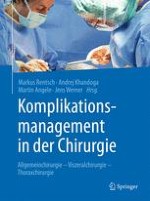Zusammenfassung
Obwohl Dünndarmresektionen vergleichsweise zu den am häufigsten durchgeführten Eingriffen zählen, ist die Komplikationsrate auch im Vergleich zu kolorektalen Resektionen vergleichsweise gering. Dies liegt im Wesentlichen an zwei Ursachen: die sehr gute Durchblutung und die fast ausnahmslos übersichtlich und spannungsfrei anzulegende Anastomose. Aus der Mobilität resultiert ein weiterer Vorteil: die Nahtverbindungen können häufig über relativ kleine bei minimalinvasiver Vorgehensweise erschwert sein kann, zumindest aber ein hohes Maß an Erfahrung erfordert. Auch die chirurgische Therapie des Ileus ist unter laparoskopischen Bedingungen anspruchsvoll und nicht unter allen Umständen in einem vernünftigen Verhältnis von Aufwand zu Nutzen realisierbar.











